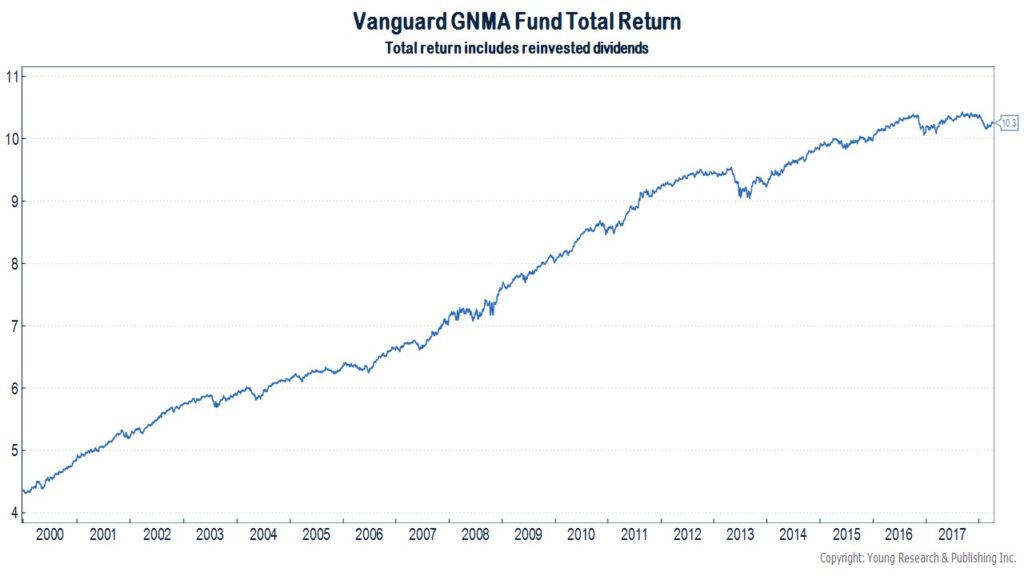When the financial crisis destroyed the stock market in 2008, guess which fund weathered the storm? You guessed it Vanguard GNMA.
When the tech bust destroyed the stock market at the beginning of this century, guess which fund weathered the storm? Right again, Vanguard GNMA.
That’s two huge busts in the stock market so far this century. Many mutual funds focus on 10-year performance. As 2018 moves forward into 2019, the brutal losses of 2008 will be rolled off, and investors may not see the risk inherent in stock funds as they make their allocation decisions. But a retirement lasts longer than 10 years.
With a 20 year retirement plan in mind, study this chart for GNMA so far this century and you’ll see what it’s like to invest through the good and the bad years and, perhaps, an entire retirement.
Survive and Thrive this Month.
Warm regards,
E.J.
“Your Survival Guy”
P.S. Is living in a van and travelling the country for you? For some baby boomers it’s the only way to travel. “‘The thing I like so much about van life is the simplicity,’ says 55-year-old John Kennedy, now on his first big road trip, to California, in his $75,000 revamped Ram ProMaster,” reports Anne Marie Chaker in the WSJ. It may not be for everyone but it sure sounds like a wonderful retirement solution for some as one commenter notes:
Different people have different tastes and interests. When traveling by airline, we only fly first class and stay in the finest hotels. Or I fly my personal turboprop anywhere I want to go.
Every summer we look forward to driving our Mercedes Sprinter RV to new places in the US. In the last 20years since retirement we have owned five of these van based units, always searching for the perfect model. Major manufacturers produce these units. You don’t have to build your own.
We enjoy a full bathroom, comfortable sleeping, eating healthy food, sitting on the lawn in the campground at night enjoying a glass of wine, mid-day naps on the side of the road, seeing all the interesting sights in our country, meeting friendly people, taking it slow, etc. It is fun to drive, even better than my Mercedes SUV.
You will only enjoy it if you love mechanical things, like tinkering, spend time learning complex systems and are comfortable with tools and know how to use them. That is half the fun. This summer’s project will be a solar upgrade and all the accoutrements. It’s one of my hobbies.
Some people really enjoy this kind of thing. Others don’t. We do.
Chaker continues:
Retirement experts say the van life reflects a new way that people want to retire. Rather than work straight through until a certain age, more people are spreading out their leisure time, whether it’s between jobs or working a few hours a week as they travel. “Boomers are reinventing retirement and saying ‘I get to live my life the way I want,’” says Jaye Smith, the 63-year-old co-founder of Reboot Partners, a consulting firm that specializes in retirement and career breaks.
For some people, sleeping in the van at night can take some getting used to. “As soon as the sun sets, I get petrified,” says Lauren Costantini, a 48-year-old former chief executive of a medical-device company who is semi-retired. “I put the window coverings up and I feel better.” She recently returned home to Boulder, Colo., after a successful four-month trip across the country on her own.
Edward Lawlor two years ago bought a custom remodeled Mercedes-Benz Sprinter van from Outside Van for $130,000, which he takes out on the road with his wife Betsy for three to five weeks every few months. The former dean at Washington University in St. Louis is semi-retired and teaches on a flexible schedule. The couple has traveled in the van through New England and Nova Scotia in the summer and to New Orleans and along the Gulf Coast in the winter.
Read more here.
P.P.S. You don’t have to be a billionaire to live like one. In Montana, there are billionaires who own ranches that seem like they’re the size of Rhode Island, but they don’t have a monopoly on: camping, hiking, bike riding, kayaking, fishing or skiing. Nature can be enjoyed by one and all.
As an aside, you know what’s interesting about that rural life? It is alive and well. The same is true of the suburbs. Not everyone wants to live or retire to the city life.
The resurgence by Millennials moving to the burbs is proof of that. For young families, there is something to having a backyard and playing outside with your kids.
But, back to Montana and the rural life. In her piece “Outdoor Recreation Driving Population Boom in Rural Areas,” Jen Fifield of The Pew Charitable Trusts writes:
While many rural counties have been shrinking for years, others with strong recreational industries, such as mountainous western towns where people can take a quick hike or southern states with year-round golfing weather, have been growing rapidly. These populations are growing as it becomes easier to work from anywhere, and as more people retire and move away from the city.
The trend is part of what drove the overall slight growth of the rural population in the United States from 2016 to 2017, for the first time since 2010, according to a Statelineanalysis of census data. (Rural counties are those defined by the U.S. Office of Management and Budget as outside cities and their suburbs.) The population in rural counties grew by only about 33,000 during that time, to about 46 million. While counties with large mining and farming industries shrank, counties with large recreation industries grew the most, by about 42,000, to about 6.3 million.
This includes Flathead County, Montana, and other counties with or near mountains, such as Teton County, Idaho, near Grand Teton National Park, which have seen double-digit population growth; and Eagle County, Colorado, home of ski towns Avon and Vail, which has grown 5 percent since 2010. Rural counties on the edges of suburbs, where land is cheaper and recreation is right out the back door, such as Wasatch and Summit counties in Utah, have also seen double-digit growth.
Read more here.
Download this post as a PDF by clicking here.
E.J. Smith - Your Survival Guy
Latest posts by E.J. Smith - Your Survival Guy (see all)
- Rule #1: Don’t Lose Money - April 26, 2024
- How Investing in AI Speaks Volumes about You - April 26, 2024
- Microsoft Earnings Jump on AI - April 26, 2024
- Your Survival Guy Breaks Down Boxes, Do You? - April 25, 2024
- Oracle’s Vision for the Future—Larry Ellison Keynote - April 25, 2024

















